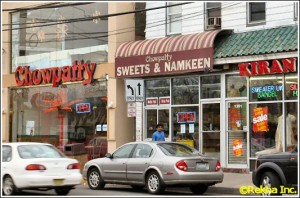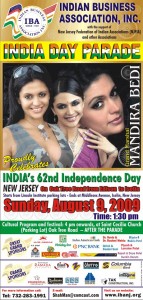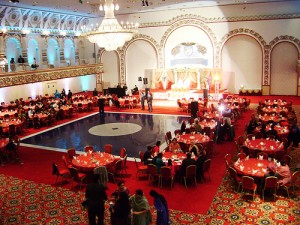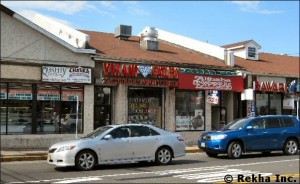September 5th, 2009 · 2 Comments
-

-
Brick Lane
-

-
Each Religion Can Be Beautiful in Its Own Right
On Wednesday our entire class went on a walk of London’s East End. After reading a few books this Summer dealing with this part of the city I had a very narrow view of what to expect before going on the tour. The East End is typically home to the most recent immigrant population of London which today is the large Bangladeshi community that has immigrated within the past 30 years. Most of the post colonial literature we read portrayed the east end and specifically Brick Lane as a dingy place where its inhabitants are trapped between their home culture and the culture of Great Britain. Often this leads to conflict and not the best living situation.
After hearing all of this negative portrayal of the East End I was surprised once we got away from Liverpool Street Station to see a quiet, unobtrusive Brick Lane. Part of this could have been attributed to Ramadan taking place which nearly all of the East End Bangladeshis observe. That being said it was evident a lot had changed in Brick Lane over the past few years. It was noticable that the city had been putting in a strong effort to change the dynamic of the area. As we concluded our walk and moved into a more well-off area near the Tower of London I realized that the image I had of the East End going into the tour was not close to what I had found. In fact the only thing that reminded me of the East End I read about was when I was riding west on the Central Line later that afternoon from Mile End to Bank and I noticed an incredible difference in the overall quality of the two Underground Stations. When hearing about Brick Lane I had expected something more akin to East St. Louis but instead found something closer to East Dublin or East Carlisle. Sarah made a great point in class today that the Brick Lane area seemed to have a bit of a “hipster” feel to it. To go along with this you’ll notice one of my hyperlinks above is connected to a series of restaurants on Brick Lane. Ten and maybe even five years ago this would never have happened. Although there were signs of immigrant communities in Brick Lane they did not become extremely noticeable until we got to the Whitechapel area. If Brick Lane is indeed becoming an area where the London mainstream is beginning to spend a good amount of time and money then where are the first generation immigrants being pushed to?
On Thursday we got to observe another area of London where immigration was prevalent as we headed to Southall, home to a large Indian community. Unlike the East End my first impression of Southall was just what I expected it to be. Walking through the area I noticed a very diverse Indian community consisting of people dressed both in western attire and in traditional south Asian clothing. Along the walk I noticed a few Churches which told me that the community has assimilated into the greater British culture a little bit. After a few more minutes of exploration we arrived outside the Gurdwara Sri Guru Singh Sabha, put scarves over our heads and prepared to head inside. Upon entering the first thing I noticed were the separate areas for men and women to hand over their shoes and cleanse themselves before prayer. The only experience I had to compare this to was when I visited a mosque many years ago and the same process took place. As we entered the main hall and waited to begin our tour I took in my surroundings. There was a man writing Punjabi on a whiteboard and a collection of men women and children wandering throughout, praying and meditating but most of all staring at the group of 28 Americans standing in the middle of the Gurdwara. Eventually our guide Mr. Singh showed up and began to tell us all about the Gurdwara and about Sikhism. The main things that I gained and understood from his quiet, pensive voice is that Sikhism is a religion of love and a religion in which learning takes place throughout one’s entire life. No Sikh has all of the knowledge in the world and each member of the community has the ability to learn from each other and from God. Mr. Singh was a very humble man and spent a lot of time continually apologizing to us that he was not a worthy guide. I sensed that humbleness is a quality found often within the Sikh religion. Although I felt slightly uncomfortable walking into the prayer room, bowing to the guru and heading back out I enjoyed my experience at the Gurdwara overall. The visit was capped off by a wonderful meal that was simple but nourishing, a metaphor of the Sikh religion as a whole.
On Friday as our class discussed the post-colonial literature we read I tried to find connections between our experience at the Gurdwara and the stories we read about. None of the books we read featured a major Sikh character so it was hard to make a direct comparison. However, one thing that I noticed that seems to apply to all immigrant groups is that there are stark differences in how the first generation and second generation handle themselves in the community. In just about every immigrant population we’ve read about/observed here in London the first generation immigrants tend to want to hold on to their home culture/religion whereas the children of first generation immigrants try to fit in with the greater British culture a bit more. This only makes sense considering the majority of them are attending public schools with other children from different backgrounds and have no experience living in the place where their parents are from. I noticed in the Gurdwara that many of the children were dressed in more western garb and wore a dew-rag type of head covering instead of a traditional scarf. Also I did not see anyone at the Gurdwara that was a teenager. It seems to me that England is very similar to the U.S. in that religion is lost on a lot of young people. I’m curious to find out if this is true throughout the world.
Overall my readings of Post-Colonial literature and my visit to the Gurdwara taught me a number of things. The first is that it is impossible to predict exactly how an immigrant group will assimilate or whether they will at all. It is also difficult to predict how each generation will handle being in a new situation. Despite these unanswered questions I learned a lot from the books we read and through our visit to the Gurdwara. I know that this learning will continue as I spend more and more time in London and as I move on throughout life. Much like the Sikh religion, learning about immigration is a lifelong task.
Tags: Henry
September 4th, 2009 · 1 Comment
Even though I am one, I rarely feel like a tourist in London. Perhaps the fact that there are hundreds of other tourists makes me feel a bit less conspicuous when I snap photos of St. Paul’s and Big Ben, or perhaps it’s because I truly feel like I’m getting to know this city bit by bit (I have a good chunk of the Tube map in my head now, which amazes me). I readily call London, Bloomsbury, and the Arran House “home” in a way I adamantly refuse to label Carlisle and Dickinson, and when I helped an American couple from California find their way on the Tube the other day, they asked if I lived here, and I automatically answered yes but didn’t realize what I had said until ten minutes later. Despite the fact that we’re often looked at on the Tube or the street for being loud and having different accents, and even though we will probably all be known as “the American” in our various social circles in Norwich, I feel more at home in London than I have ever felt outside of my Connecticut bubble.
Yesterday, however, I felt like a tourist and an outsider for the first time in a while. Southall immediately felt foreign the second I got off the train. Perhaps this is because of my relative lack of experience with England outside of greater London, or perhaps it was because of the street signs and advertisements in Urdu, but Southall only felt more foreign the farther we got into it. Even just walking down the street, I felt that we were being looked at and wondered about much more closely and obviously than we often are around Tottenham Court Road, for example. From what I’ve paid attention to, many Brits will hear a bunch of loud young adults with American accents walking down the pavement, and they seem to give us a cursory glance when they’re sure we’re not looking before walking on. In Southall, on the street as well as in the gurdwara itself, people didn’t seem to hide their blatant staring at our group. This didn’t feel unfriendly, necessarily, or undeserved: Southall isn’t exactly an area that sees a lot of tourists, especially young, mostly white Americans, and I bet many were wondering why the hell we had reason to come to Southall. In the gurdwara, people didn’t seem to hide their curiosity whatsoever, but this time I felt a slight embarrassment: even though we were all being respectful and obeying their customs, I wondered what they thought of us being there and if they felt mocked by our curiosity, our sometimes comical scarf-wearing, and our close observation. I felt as though we might be intruding into their sacred space, perhaps one of the few places in Britain where they are among their own kind and NOT the outsiders, simply by being there and treating the gurdwara like it was another tourist stop on the tour of England and as a space that does double-duty as a museum as well as a space of worship like Westminster Abbey or St. Paul’s.
As we discussed in class today, for many of us, being an outsider is an infrequent and uncomfortable experience, but I wholeheartedly agree with such experiences being beneficial, educational, and healthy. However, after feeling like a complete outsider for the first time in a while, I found myself reflecting on how the gurdwara is probably one of the only places in the area where the Sikhs aren’t the outsiders and aren’t given strange looks for having turbans and beards. For the hour or however long they’re in the gurdwara, they are able to be themselves and focus on what matters most to them, but in the outside world, where they’re not even allowed to participate fully in the requirements of their religion (since they aren’t allowed to carry knives/swords, and in some professions, might not be able to have long hair or beards), they are constantly bombarded with strange looks and being “foreign” just because of the way they look. I wonder what this does to a Sikh’s identity, especially through the various generations and levels of devoutness. We have read several books on the concepts of being an immigrant and a permanent outsider in England, but since Sikhs can perhaps stick out even MORE due to the physical markers of their religion. I also think that identity varies from individual to individual, even though two might come from the same place at the same age and live in the same new environment, and I regret not asking our guide more about the Sikh identity in a secular, western community.
Tags: Chelsea

"Little India"
I haven’t missed home much during the past two weeks. We have been so busy with tours and museums and plays that I simply haven’t had time to be homesick–until yesterday and today. London’s East End and Southall reminded me so much of my hometown that I couldn’t help but long for good old Iselin, a place I took for granted before I came to college.
The town I’m from is extremely diverse and has a large South Asian population. For example, the top languages spoken in my high school (as of 2008) are English, Gujarati, Spanish, Urdu, Panjabi, Hindi, and Tagalog. Oak Tree Road and Green Street, the two main roads running through Edison and Iselin, NJ are lined with sari shops, curry houses, cash and carries, and more. The annual India Day Parade is the biggest event around and Bollywood stars are commonplace on billboards.
Growing up, I never really realized or appreciated the cultural diversity I experienced on an everyday basis. Even though the Indian/Bengali population has left the greatest mark on my area, there are numerous people of other backgrounds who reside in my area. The example I often use to make this point is if you come to visit me, I can find ANY kind of restaurant you can think of (Indian, Japanese, Chinese, Thai, Greek, Mexican, Spanish, Kosher, Portuguese, Mongolian, Polish, and Ethiopian are the ones I can list off the top of my head). Before coming to Dickinson and Carlisle, I never really thought about how much of the rest of the United States is, in fact, not like this at all.

Advertisement for the India Day Parade on Oak Tree Rd.
Living in such a culturally diverse place has not always led to positive experiences. As we’ve seen and heard of in London, there is a lot of ethnic tension in my area due the sudden boom of immigrants that started in the 1990s. I’ve heard my friend’s parents refer to their neighbors as the “terrorists down the street,” and “dot-heads,” “deets,” and “hajis,” are only a few of the pejorative terms heard on a regular basis. I remember one of the blog posts mentioned an altercation between a white man and a South Asian man in a market, which reminded me of a time I was in the Target by my house and a white man shouted at the Indian man in front of him in line to, “go take a fucking shower and come back when you know some fucking English.” Another friend’s mother claimed that the Indians “stole” our Christmas light and use them for their holidays, disregarding the fact that Diwali is the Festival of Lights and electric lights are common decorations for purposes other than Christmas. I’ve even lost one friend within the past year because I refused to put up with his increasingly racist comments any longer.
I hope that this relatively new immigrant group will in time become more accepted in both American and British society. However, I might be rather pessimistic or cynical, as I can’t help but think that a new population will replace the lowest rung on the social ladder once this is allowed to move up. What I know for sure, though, is that all I can do is my part to try to fight intolerance and racism so that people might realize all of the wonderful things various cultures have to offer.

Royal Albert's Palace--An Indian catering hall where my friend had her Sweet 16

Oak Tree Road
Tags: Sarah
I believe that ours has become a culture of fear. Not only, but especially since 9/11, we have begun to fear those of different cultures and those of different appearances, more than I think we ever have before. While many of you may find this a very controversial statement, I think it has become a truth that we all live with everyday. As students in a foreign country, we spend our time fighting this growing reality. We study other cultures, we learn about the unknown so that we will not fear it. But ultimately, Americans live in a society that is suspicious of the unknown.
So when we entered the Sikh Gurdwara in Southall, I’ll admit I was uneasy. However, it is not about that uneasy feeling, the uncomfortable awareness of difference, that I mean to write about tonight, but rather something that our generous guide earnestly said to us. After covering our heads, removing our shoes, washing our hands, touring the Gurdwara, and hearing about the Sikh faith, Professor Qualls asked our guide about the traditional kirpan sword that practicing Sikhs would normally wear at their side at all times. The guide did explain –to my understanding—that they are allowed to wear them on the street etc, because it part of their faith and is not considered a weapon. However, he did note that they are still not allowed to travel with them on airplanes. He stated that, “[Sikhs] sometimes stand out because of what we wear. People may see us with a kirpan and think we are going to try to take over the plane. But it would be better if we could take them because if someone were to try to take the plane, we would be able to stand up and say ‘no! do not do that!’ I know that someday we will be able to take them with us when we travel. People will see us with it and say, ‘No, he is a Sikh, he will not hurt us. Let him have it.” Perhaps I am more of a jaded American city girl than I ever thought, because hearing this man honestly tell us this belief for the future moved me more than anything else said that morning.
Part of the Sikh tradition is to protect the innocent. They carry this sword with them at all times because it is their duty to protect themselves and those who cannot protect themselves. This man had such faith in the British people, in the American people, in the growing cultural world, that someday he saw people not only accepting his faith, but understanding and allowing him to practice all the aspects of it, even if it involved carrying weapons.
It was a deeply powerful moment, to feel someone else’s hopes, however naïve you may think them, and to know, that are not in any future you foresee. As much as this experience in another culture, which despite similar languages is very different from my own, has opened my eyes to many wonderful differences and helped me to be even more accepting, I do not know that I can believe the same openness is possible on a worldwide scale. After all, we are a people who are afraid of differences. And while that can change one person at a time, we still have a long way to go.
Note: No photographs were allowed in the temple so I did not bring my camera along on this trip. However, if you would like to see images of the area, check out Google Images of Southall.
Tags: Megan






